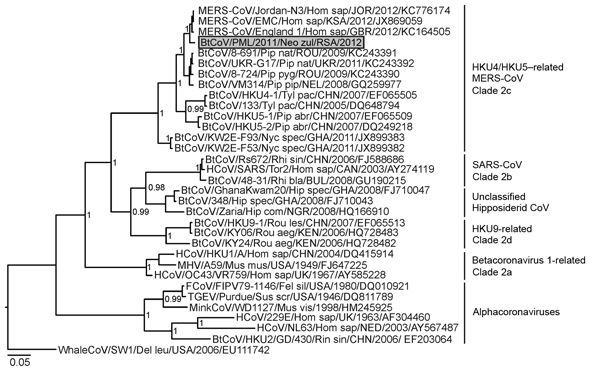Volume 19, Number 10—October 2013
Letter
Close Relative of Human Middle East Respiratory Syndrome Coronavirus in Bat, South Africa
Figure

Figure. . Partial RNA-dependent RNA polymerase (RdRp) gene phylogeny, including the novel betacoronavirus from a Neoromicia zuluensis bat in South Africa (GenBank accession no. KC869678 for both partial RdRp and spike gene sequences). The Bayesian phylogeny was done on a translated 816-nt RdRp gene sequence fragment, as described (5). MrBayes V3.1 (http://mrbayes.sourceforge.net/) was used with a WAG substitution model assumption over 2,000,000 generations sampled every 100 steps, resulting in 20,000 trees, of which 25% were discarded as burn-in. A whale gammacoronavirus was used as an outgroup. The novel N. zuluensis bat virus is highlighted in gray. Values at deep nodes represent statistical support from posterior probabilities. Only values >0.9 are shown. Coronavirus clades are depicted to the right of taxa. Scale bar represents genetic distance. MERS-CoV, Middle East respiratory syndrome coronavirus; SARS, severe acute respiratory syndrome; Bt-CoV, bat coronavirus; HCoV, human coronavirus, MHV, mouse hepatitis virus; FCoV, feline coronavirus; TGEV, transmissible gastroenteritis coronavirus.
References
- Zaki AM, van Boheemen S, Bestebroer TM, Osterhaus AD, Fouchier RA. Isolation of a novel coronavirus from a man with pneumonia in Saudi Arabia. N Engl J Med. 2012;367:1814–20. DOIPubMedGoogle Scholar
- Reusken CB, Lina PH, Pielaat A, de Vries A, Dam-Deisz C, Adema J, Circulation of group 2 coronaviruses in a bat species common to urban areas in Western Europe. Vector Borne Zoonotic Dis. 2010;10:785–91. DOIPubMedGoogle Scholar
- Annan A, Baldwin HJ, Corman VM, Klose SM, Owusu M, Nkrumah EE. Human betacoronavirus 2c EMC/2012–related viruses in bats, Ghana and Europe. Emerg Infect Dis. 2013;19:456–9. DOIPubMedGoogle Scholar
- Geldenhuys M, Weyer J, Nel LH, Markotter W. Coronaviruses in South African bats. Vector Borne Zoonotic Dis. 2013;13:516–9. DOIPubMedGoogle Scholar
- Drexler JF, Gloza-Rausch F, Glende J, Corman VM, Muth D, Goettsche M, Genomic characterization of severe acute respiratory syndrome–related coronavirus in European bats and classification of coronaviruses based on partial RNA-dependent RNA polymerase gene sequences. J Virol. 2010;84:11336–49. DOIPubMedGoogle Scholar
- Woo PC, Wang M, Lau SK, Xu H, Poon RW, Guo R, Comparative analysis of twelve genomes of three novel group 2c and group 2d coronaviruses reveals unique group and subgroup features. J Virol. 2007;81:1574–85. DOIPubMedGoogle Scholar
- Falćon A, Vazquez-Moron S, Casas I, Aznar C, Ruiz G, Pozo F, Detection of alpha and betacoronaviruses in multiple Iberian bat species. Arch Virol. 2011;156:1883–90. DOIPubMedGoogle Scholar
- Wacharapluesadee S, Sintunawa C, Kaewpom T, Khongnomnan K, Olival KJ, Epstein JH. Group C betacoronavirus in bat guano fertilizer, Thailand. Emerg Infect Dis. 2013; Epub ahead of print.
- Anthony SJ, Ojeda-Flores R, Rico-Chavez O, Navarrete-Macias I, Zambrana-Torrelio C, Rostal MK, Coronaviruses in bats from Mexico. J Gen Virol. 2013;94:1028–38. DOIPubMedGoogle Scholar
- Bird BH, Khristova ML, Rollin PE, Ksiazek TG, Nichol ST. Complete genome analysis of 33 ecologically and biologically diverse Rift Valley fever virus strains reveals widespread virus movement and low genetic diversity due to recent common ancestry. J Virol. 2007;81:2805–16. DOIPubMedGoogle Scholar
1These authors contributed equally to this article.